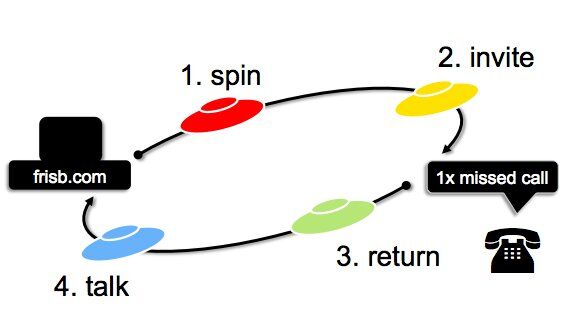frisB is an interesting startup that uses WebRTC to generate missed calls from the web to your phone.
I hope this is the first of many such interviews. I have decided to go and hunt for WebRTC companies – those startup disruptors entering the telecom industry using WebRTC and an innovative idea.
 The first one in this series is going to be frisB, where Terry Shatenstein, a Co-founder at frisB, was kind enough to answer a few questions for me.
The first one in this series is going to be frisB, where Terry Shatenstein, a Co-founder at frisB, was kind enough to answer a few questions for me.
What is frisB all about?
frisB is a highly magnetic voice channel that permits any internet user to freely ring and invite any telephone user in the world to talk. It’s a digital fusion between flying discs and telecoms 🙂
Internet users spin virtual discs to phones around the world inviting them to talk. Discs present as “missed calls” listing the local frisB dialback number. When the phone returns the call the web catches and connects free. Effectively a net user can instantly and freely reverse connect to any phone on the planet and critically without any payment whatsoever. We are the only service delivering free global telecoms on this convergence model. It has never been done before.

Why generate missed calls in the first place?
Trying to convert free net users to paying is almost impossible. It’s the proverbial billing brick wall. We wanted to change the landscape and the thinking … to converge rather than convert the free masses to paying: Consumer VoIP is a fiercely competitive business as free becomes cheap and cheap becomes cheaper in what is a classic industry caught in a penny gap. On the internet requesting any payment no matter how small inhibits mass adoption.
Look at search, can you imagine how big Google would be if you had to pay?
We saw the opportunity to light up the cloud and industry with seamless origination rather than termination which means the user on the web receives an incoming free connection rather than incurring an outgoing paying one.
This subtle yet profound connection reversal changes almost nothing yet changes almost everything:
The mass free can now pull in their mobile social and paying contacts up into the cloud since we can virtualize VoIP by presenting it at the highest telephony interface abstraction: the missed call manager.
Missed calls can present a gateway callback number that hooks any phone into the cloud and keeps everything in the telephony domain. Missed calls also permits us to fly in under the billing radar and then back over the billing brick wall … stimulating increased call origination on the carriers network.
How did you come up with the idea?
We are a “virtual telco” with global aspirations and built the service so we could talk freely over the Atlantic Ocean between the USA and South Africa. We found that day/night time zones often had “one at PC and the other mobile and off the 3G grid” and were frustrated with exorbitant international direct calling rates and the constant “harassing to add Skype credit to call phones.” We wanted to make global phone calls without paying and without prescribing the environment and time zones.
We love playing “frisbee” and found it to embody the perfect callback analog (“throw it out there and catch the return”). So we modeled a phone service on the game, “simple enough for a child of 5”.
And then fell in love with it.
We now play “intercontinental frisB” daily. It has become an essential service to us and we are passionate about sharing it with others, one by one, by word of mouth.
What part did WebRTC take in it?
The native voice drivers are key to WebRTC as is the fact that users do not require plugins. Native gives highest quality lowest latency. We started out with Java, however Java is on a “descending vector” and has many challenges including reliable microphone access and end user acceptance. Flash was never a contender for us because poor audio quality compromises the conversation.
How did you find the integration with it? What worked, what didn’t?
Embracing WebRTC so early on in its dev cycle has proven to be remarkably stable with exceptional audio quality. You know this when conversations begin to shift from “discussing the quality of the connection to holding real conversations” … when the technology disappears into the background.
This is in part due to native access to device drivers and given that we leverage the “best of both worlds … packet switched on IP and circuit switched on telephones”
On the integration you really have to ask our lead engineer Ashley Brener as he did the integration, and our PSTN interworking specialist Klaus-Peter Junghanns who developed an ultra lightweight gateway.
“WebRTC API changes have been a significant challenge because during the WebRTC development cycle the product is not necessarily backward compatible from version to version and frisB needed to support all previous and current versions while also playing on the Chrome Canary channel which is the latest rendition. This makes having a past, present and future view of the WebRTC universe quite challenging as is the fact that Chrome Broswers mostly update in the background without any (developer) notice. However this is what living on the edge is all about … building and launching the rocket ship at the same time.”
What would you change in WebRTC if you were given that choice?
The one fundamental change we would make and would still like to see given the standards process is still a work in progress is support for plain legacy RTP/STUN under application control rather than mandating (secure) SRTP/ICE as the only supported media transport.
RTP would permit seamless meshing between browser and legacy PSTN gateways without requiring a media plane interworking server that has to translate between plain RTP and secure RTP. This is a very expensive interworking component because it requires the provider to carry the media whereas supporting a common protocol permits peer to peer traffic.
What are your plans ahead for frisB?
While frisB is still in its infancy as an MVP (minimal viable product) and minimalist features it has a passionate and small community that has already clocked over 1000+hrs (60,000 minutes) of talk time. A key metric that has emerged from our small user base is that since calls are rendezvoused they last longer. The average off net VoIP calls is mere minutes whereas frisB calls average 20 minutes or more.
Our vision is simple and singular … to evolve our service into the next long distance carrier.
WebRTC offers also video. Why only voice?
Being ultra-minimalists we have very little interest in video calling. Face time consumes far too much bandwidth. Video is at best a visual distraction and you cannot beat pure voice for real world connections. There is a reason the global trillion dollar telephony industry is predicated on voice. If it were video it would best be a “poorly dubbed movie” 🙂
–
Make sure to check out the frisB service!

I’ve tried the service today after some dude in the shop saw me buying a real frisbee and told me about it 😀
It works, but I’m waiting to make this for the mobile browser 🙂
Cheers from Cape Town
I very much liked it, but their website is not found anymore. Why they stoped it? Very sad its gone!
it was working in the past, but now 2 years it is not working anymore, It never rings the phone, i need to send an invitation and then they get the phone numbeer for calling, when it gets finally connected it hangs the phone up after 30 seconds. thats it. very sad.